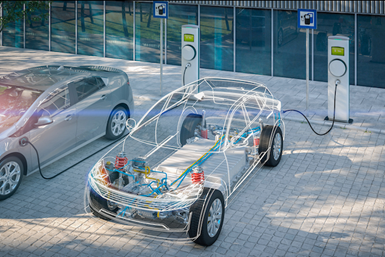Tin and Tin Zinc Overview and Growth
Brett Larick of Columbia Chemical discusses the increasing demand for conductive finishes driven by the increasing electrification of vehicles.

The growing EV market is driving a need for conductive finishes.
Photo Credit: Getty Images
Q. We currently have the capacity to add another process in a mid-volume barrel line and we are starting to hear requests for tin and tin-zinc plating. It seems this may connect to automotive work, and we know not many local platers offer either of these finishes. Can you provide an overview on each and comment on what may be driving the interest?
A. There is indeed growing interest in tin and tin-zinc plating processes, and this growth is relative to the electric vehicle (EV) market. Both processes offer benefits that meet specific needs in the overall design of battery electric vehicles, with tin plating being used heavily for copper busbars and tin-zinc being ideally suited to the numerous fasteners required on EVs. As you point out, it is not uncommon to see a gap in your marketplace for these plating services, especially tin-zinc, which has a rather limited number of applicators, both in the U.S. and globally. As demand grows to meet the burgeoning EV market, you can anticipate this gap will shift, so exploring this opportunity while you have additional capacity may be well-timed.
Tin plating provides a finish that offers a superior level of solderability, great corrosion resistance, strong electrical conductivity and good ductility. Offered in a matte and bright finish, tin plating can be used for both decorative and functional applications. It is RoHS-compliant, non-toxic, and FDA-approved for safe use in the food industry, with its most widespread use being for tin cans. Its ductility allows parts plated with tin to be bent, stamped, or formed without sacrificing corrosion protection. Due to its excellent conductivity, tin is used for the transfer of electrical power in various manners throughout the transportation, construction, manufacturing and energy industries. As mentioned previously, in the automotive industry, tin plating on copper bus bars is the most common application as it delivers reliable transfer of current. Copper busbars and associated automotive components play a critical role in electric vehicles and this reality is driving OEM design and materials engineers to submit research and cost requests out into the industry as they plan to address this growing need.
Pure tin can offer challenges due to whisker growth which can cause a short in electronics. This is a case where alloys such as tin-zinc come into the picture. A key performance element of tin-zinc is that it will not form whiskers, making it ideal for electrical applications. Small fasteners coated in tin-zinc are often used for circuit boards. From a galvanic reaction standpoint, we know tin is more noble than steel (cathodic) and therefore will not be sacrificial. Zinc is more active (anodic) to steel and will protect the underlying substrate. An industry standard alloy composition of approximately 70/30% tin-zinc will offer the proper balance to galvanically protect the substrate and provide the needed corrosion protection. As a result, tin-zinc provides great benefits in this respect, delivering approximately 48 hours to first white rust and 1,000 hours to red. As with tin, the ductility available with the tin-zinc process allows for post-plate bending or crimping to occur while still maintaining corrosion resistance.
Tin-zinc and tin alloys are used frequently in the military for electronic applications. Because of its beneficial non-whiskering properties, tin-zinc is the right fit for EVs. As a result, OEMs have established that tin-zinc usage will increase on fasteners for this market application. Approximately 80% of the fasteners utilizing tin-zinc plating are smaller (M8 and below) which would work well in your scenario with a mid-volume barrel line. From a cost perspective, it is worth noting that tin-zinc tends to run closer to zinc-nickel because of the 70/30 alloy content favoring the higher-cost tin over zinc. With the increase in fasteners that will require tin-zinc going forward, there is also a demand for torque tension modifiers specially designed to work with this coating, so it is important to consult with a knowledgeable chemistry supplier to ensure you can meet this need for any tin-zinc fastener work.
An additional finish to consider that is seeing extreme growth in the automotive market and will continue to be propelled forward by the electric vehicle market is zinc-nickel. There is a tremendous amount of resources and information available on the growth and demand of this finish, so it may also be worth exploring as you consider your options to meet future demands for your automotive customers.
To review, as the automotive industry continues to evolve, usage for battery/electric technology and its components will continue to increase, which will drive additional interest and demand for conductive metal plating processes such as tin and tin-zinc. Demand exists for both processes relative to the growing EV segment of the automotive market. It would be best to consider the specifics of your available line capacity and further explore the customer requests you are receiving within your direct market to aid in your overall decision process.
About the Author

Brett Larick
Brett Larick is President/CEO at Columbia Chemical. Visit columbiachemical.com
Related Content
Innovation in Plating on Plastic
Plating on advanced plastics solution offers improved adhesion, temperature resistance and cost savings.
Read MoreA Chromium Plating Overview
An overview of decorative and hard chromium electroplating processes.
Read MoreNanotechnology Start-up Develops Gold Plating Replacement
Ag-Nano System LLC introduces a new method of electroplating based on golden silver nanoparticles aimed at replacing gold plating used in electrical circuits.
Read MorePossibilities From Electroplating 3D Printed Plastic Parts
Adding layers of nickel or copper to 3D printed polymer can impart desired properties such as electrical conductivity, EMI shielding, abrasion resistance and improved strength — approaching and even exceeding 3D printed metal, according to RePliForm.
Read MoreRead Next
Delivering Increased Benefits to Greenhouse Films
Baystar's Borstar technology is helping customers deliver better, more reliable production methods to greenhouse agriculture.
Read MoreEducation Bringing Cleaning to Machining
Debuting new speakers and cleaning technology content during this half-day workshop co-located with IMTS 2024.
Read MoreA ‘Clean’ Agenda Offers Unique Presentations in Chicago
The 2024 Parts Cleaning Conference, co-located with the International Manufacturing Technology Show, includes presentations by several speakers who are new to the conference and topics that have not been covered in past editions of this event.
Read More












.jpg;maxWidth=300;quality=90)








